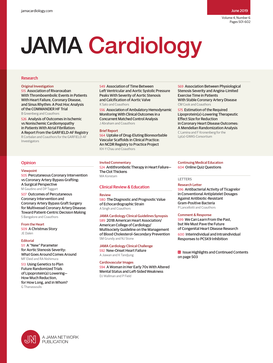肥厚性心肌病患者睡眠呼吸暂停的患病率及临床意义
IF 14.1
1区 医学
Q1 CARDIAC & CARDIOVASCULAR SYSTEMS
引用次数: 0
摘要
睡眠呼吸障碍(SDB)是一种公认的心血管疾病,由间歇性低氧血症、自主神经失调和内皮功能障碍介导。肥厚性心肌病(HCM)患者可能特别容易发生SDB,但SDB在这一人群中的临床影响尚不清楚。目的确定HCM患者SDB的患病率和亚型,并探讨其与超声心动图参数和心脏生物标志物表达的关系。设计、环境和参与者:一项前瞻性队列研究于2018年4月18日至2024年1月15日在一家专门从事HCM护理的三级转诊中心进行。成人HCM(左室壁厚度≥15mm或致病变异)从一个机构登记中心招募。被诊断为SDB或目前怀孕的患者被排除在外。患者接受多导睡眠描记术,超声心动图、心电图和生物标志物指标进行比较评估。观察者对多导睡眠图结果不知情。数据分析时间为2024年4月11日至2024年7月25日。使用呼吸暂停-低通气指数阈值,通过多导睡眠图对sdb进行分类,其中包括阻塞性睡眠呼吸暂停和中枢性睡眠呼吸暂停亚型,并量化事件严重程度、低氧血症和睡眠结构破坏。超声心动图指标、心脏生物标志物表达、功能状态、呼吸暂停-低通气指数和夜间低氧血症。结果154例患者(中位[IQR]年龄60[48-68]岁,男性102例(66.2%))中,91例(59.1%)确诊为SDB。与无SDB的患者相比,SDB患者的左室质量指数(中位数[IQR], 128 [107-161] vs 109 [96-134] g/m2, P = 0.03)、E/ E比值(中位数[IQR], 12.5 [10.0-15.0] vs 10.0 [8.3-14.5], P = 0.04)和基线肌钙蛋白- t水平(中位数[IQR], 0.013 [0.009-0.022] vs 0.011 [0.007-0.015] ng/mL[换算成微克/升,乘以1];P = 0.04)和更大的夜间肌钙蛋白- t水平升高(中位数[IQR]变化,0.0021[- 0.0029至0.0062]vs 0.0002[- 0.0022至0.0026]ng/mL; P = 0.02)。纽约心脏协会II级或III级症状在SDB患者中更为常见(48例[52.7%]vs 17例[27.0%];P = 0.005)。高血压和糖尿病在患有SDB的患者中比不患有SDB的患者更普遍(高血压:67 [73.6%]vs 36 [57.1%]; P = .03;糖尿病:14 [15.4%]vs 3 [4.8%]; P = .04),而房颤和既往肌瘤切除术的发生率在两组之间无显著差异。本研究提示,HCM患者中未确诊的SDB非常普遍,且SDB与不良心肌重构、舒张功能障碍加重、肌钙蛋白- t水平升高相关,提示亚临床心肌损伤。SDB可能与HCM的病理生理和症状负担有关,支持随机临床试验的基本原理,以确定治疗SDB对HCM患者症状和临床结局的影响。本文章由计算机程序翻译,如有差异,请以英文原文为准。
Prevalence and Clinical Implications of Sleep Apnea in Hypertrophic Cardiomyopathy
ImportanceSleep disordered breathing (SDB) is a well-established contributor to cardiovascular morbidity, mediated by intermittent hypoxemia, autonomic dysregulation, and endothelial dysfunction. Patients with hypertrophic cardiomyopathy (HCM) may be especially at risk for SDB, but the clinical impact of SDB in this population remains unclear.ObjectiveTo define the prevalence and subtypes of SDB in HCM and examine their association with echocardiographic parameters and cardiac biomarker expression.Design, Setting, and ParticipantsA prospective cohort study was conducted between April 18, 2018, and January 15, 2024, at a single tertiary referral center specializing in HCM care. Adults with HCM (left ventricular wall thickness ≥15 mm or pathogenic variants) were recruited from an institutional registry. Patients diagnosed with SDB or current pregnancy were excluded. Patients underwent polysomnography, with comparative assessment of echocardiographic, electrocardiographic, and biomarker indices. Observers were blinded to polysomnographic results. Data analysis was performed from April 11, 2024, to July 25, 2024.ExposuresSDB classified via polysomnography using apnea-hypopnea index thresholds, with subtypes including obstructive sleep apnea and central sleep apnea and with event severity, hypoxemia, and sleep architecture disruption quantified.Main Outcomes and MeasuresEchocardiographic indices, cardiac biomarker expression, functional status, apnea-hypopnea index, and overnight hypoxemia.ResultsAmong 154 patients (median [IQR] age, 60 [48-68] years; 102 [66.2%] male), 91 (59.1%) were diagnosed with SDB. Those with SDB, compared with those without SDB, had higher left ventricular mass index (median [IQR], 128 [107-161] vs 109 [96-134] g/m2 ; P = .03), E/e′ ratio (median [IQR], 12.5 [10.0-15.0] vs 10.0 [8.3-14.5]; P = .04), and baseline troponin-T level (median [IQR], 0.013 [0.009-0.022] vs 0.011 [0.007-0.015] ng/mL [to convert to micrograms per liter, multiply by 1]; P = .04) and greater overnight troponin-T level increases (change in median [IQR], 0.0021 [−0.0029 to 0.0062] vs 0.0002 [−0.0022 to 0.0026] ng/mL; P = .02). New York Heart Association class II or III symptoms were more common in those with SDB (48 [52.7%] vs 17 [27.0%]; P = .005). Hypertension and diabetes were more prevalent among patients with SDB than without SDB (hypertension: 67 [73.6%] vs 36 [57.1%]; P = .03; diabetes: 14 [15.4%] vs 3 [4.8%]; P = .04), whereas rates of atrial fibrillation and prior myectomy did not differ significantly between groups.Conclusions and RelevanceThis study suggests that undiagnosed SDB is highly prevalent in patients with HCM and that SDB is associated with adverse myocardial remodeling, greater diastolic dysfunction, and elevated troponin-T levels, indicating subclinical myocardial injury. SDB may contribute to HCM pathophysiology and symptom burden, supporting the rationale for randomized clinical trials to determine the impact of treating SDB on symptoms and clinical outcomes in patients with HCM.
求助全文
通过发布文献求助,成功后即可免费获取论文全文。
去求助
来源期刊

JAMA cardiology
Medicine-Cardiology and Cardiovascular Medicine
CiteScore
45.80
自引率
1.70%
发文量
264
期刊介绍:
JAMA Cardiology, an international peer-reviewed journal, serves as the premier publication for clinical investigators, clinicians, and trainees in cardiovascular medicine worldwide. As a member of the JAMA Network, it aligns with a consortium of peer-reviewed general medical and specialty publications.
Published online weekly, every Wednesday, and in 12 print/online issues annually, JAMA Cardiology attracts over 4.3 million annual article views and downloads. Research articles become freely accessible online 12 months post-publication without any author fees. Moreover, the online version is readily accessible to institutions in developing countries through the World Health Organization's HINARI program.
Positioned at the intersection of clinical investigation, actionable clinical science, and clinical practice, JAMA Cardiology prioritizes traditional and evolving cardiovascular medicine, alongside evidence-based health policy. It places particular emphasis on health equity, especially when grounded in original science, as a top editorial priority.
 求助内容:
求助内容: 应助结果提醒方式:
应助结果提醒方式:


